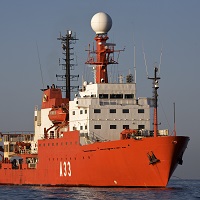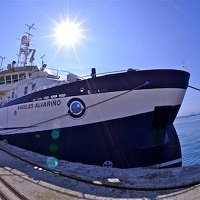Keyword
transmissometers
69 record(s)
Type of resources
Categories
Topics
INSPIRE themes
Keywords
Contact for the resource
Provided by
Years
Formats
Status
-

In January 2012, a physical-geological mooring was installed to the East of Elephant Island onboard the RV Hesperides. The mooring was constituted by current meters, temperature, conductivity, and pressure sensors located at selected depths. The mooring was deployed for one year period, and successfully recovered on January 23rd 2013 during the Hesperides Antarctic Survey 2012-2013. The goal of the experiment is to monitor the presence / absence of the Antarctic slope front over the southern slope of the South Scotia Ridge. The addition of a sediment trap will allow to identify the terrigenous / biogenic composition of the flow suspended particles. In an international context, the collected data will be used to optimize the MITgcm Antarctic regional model (ECCO2/ECCO3 project, JPL/Caltech).
-

The goals of this campaign are framed within the objectives of the overall project 'Radial Profunda de Canarias', being the experimental cruise of the proposal. Thus, this cruise will help to: • Determine the structure of the current when it reaches the Canary Islands, of the Outcrop Current and the polar counterflow of slope in its passage through the Canary Archipelago and the African slope, stimating its mass transport, heat and nutrients. • Characterize the different modes of variability of heat and mass transport in easternorth atlantic subtropical gyre and the oucrop in northwest African coast. • Characterize the annual cycle in the physical conditions of the surface layers and mixture to where the seasonal cycle is significant, relating it to the meteorological forcings. • Characterization of changes in water masses, mainly in the North Atlantic Central Water (NACW), in Antarctic Atlantic Intermediate Water (AAIW) in Mediterranean Water (MW), bottom waters of the Canary Basin and the oucrop in northwest African coast, in based on temperature, salinity, nutrients and oxygen. • To characterize the zooplancton and micronecton deep communities. • To charactereze the microbian and heterotrophic communities.
-

The goals of this campaign are framed within the objectives of the overall project 'Radial Profunda de Canarias', being the experimental cruise of the proposal. Thus, this cruise will help to: • Determine the structure of the current when it reaches the Canary Islands, mass transport, heat and nutrients and interannual variability. • Characterize the different modes of variability of heat and mass transport in easternorth atlantic subtropical gyre. • To determine the correlation between heat and mass transport with the NAO atmospheric and oceanic index. • Characterize the annual cycle in the physical conditions of the surface layers and mixture to where the seasonal cycle is significant, relating it to the meteorological forcings. • Characterization of changes in water masses, mainly in the North Atlantic Central Water (NACW), in Antarctic Atlantic Intermediate Water (AAIW) in Mediterranean Water (MW) and bottom waters of the Canary Basin, in based on temperature, salinity, nutrients and oxygen.
-

The goals of this campaign are framed within the objectives of the overall project 'Radial Profunda de Canarias', being the experimental cruise of the proposal. Thus, this cruise will help to: • Determine the structure of the current when it reaches the Canary Islands, of the Outcrop Current and the polar counterflow of slope in its passage through the Canary Archipelago and the African slope, stimating its mass transport, heat and nutrients. • Characterize the different modes of variability of heat and mass transport in easternorth atlantic subtropical gyre and the oucrop in northwest African coast. • Characterize the annual cycle in the physical conditions of the surface layers and mixture to where the seasonal cycle is significant, relating it to the meteorological forcings. • Characterization of changes in water masses, mainly in the North Atlantic Central Water (NACW), in Antarctic Atlantic Intermediate Water (AAIW) in Mediterranean Water (MW), bottom waters of the Canary Basin and the oucrop in northwest African coast, in based on temperature, salinity, nutrients and oxygen. • Characterize the abundance and diversity of autotrophic microorganisms and heterotrophs throughout the water column. • Characterize the concentration of dissolved organic carbon (DOC) and carbon Particulate Organic (POC) in seawater at different depths. • Implement a system for measuring the 12C / 13C isotopic ratio of CO2 and CH4 dissolved in seawater from discrete samples obtained at different depths. • In collaboration with the project Persistence of Organic Substrates Explained in Diluted Oceanic eNvironments (POSEIDON), material concentrates will be made dissolved organic matter (DOM) from different deep water bodies (mainly NADW). • Vertical fishing will be carried out with WP2 plankton net in order to determine the abundance and zooplanktonic biomass up to 200m of depth, among others. • Characterize the structure, abundance and distribution of the community ichthyoplankton in waters of the Canary archipelago, paying special attention to the eggs of small pelagic larvae (sardines and anchovies) and the larvae of Apical predators (scombids) in relation to the hydrographic scene of the study zone.
-

The goals of this campaign are framed within the objectives of the overall project 'Sevacan', being the experimental cruise of the proposal. Thus, this cruise will help to: • Determine the structure of the current when it reaches the Canary Islands, mass transport, heat and nutrients and interannual variability. • Characterize the different modes of variability of heat and mass transport in easternorth atlantic subtropical gyre. • To determine the correlation between heat and mass transport with the NAO atmospheric and oceanic index. • Characterize the annual cycle in the physical conditions of the surface layers and mixture to where the seasonal cycle is significant, relating it to the meteorological forcings. • Characterization of changes in water masses, mainly in the North Atlantic Central Water (NACW), in Antarctic Atlantic Intermediate Water (AAIW) in Mediterranean Water (MW) and bottom waters of the Canary Basin, in based on temperature, salinity, nutrients and oxygen.
-

The goals of this campaign are framed within the objectives of the overall project 'Radial Profunda de Canarias', being the experimental cruise of the proposal. Thus, this cruise will help to: • Determine the structure of the current when it reaches the Canary Islands, mass transport, heat and nutrients and interannual variability. • Characterize the different modes of variability of heat and mass transport in easternorth atlantic subtropical gyre. • To determine the correlation between heat and mass transport with the NAO atmospheric and oceanic index. • Characterize the annual cycle in the physical conditions of the surface layers and mixture to where the seasonal cycle is significant, relating it to the meteorological forcings. • Characterization of changes in water masses, mainly in the North Atlantic Central Water (NACW), in Antarctic Atlantic Intermediate Water (AAIW) in Mediterranean Water (MW) and bottom waters of the Canary Basin, in based on temperature, salinity, nutrients and oxygen.
-

The goals of this campaign are framed within the objectives of the overall project 'Radial Profunda de Canarias', being the experimental cruise of the proposal. Thus, this cruise will help to: • Determine the structure of the current when it reaches the Canary Islands, mass transport, heat and nutrients and interannual variability. • Characterize the different modes of variability of heat and mass transport in easternorth atlantic subtropical gyre. • To determine the correlation between heat and mass transport with the NAO atmospheric and oceanic index. • Characterize the annual cycle in the physical conditions of the surface layers and mixture to where the seasonal cycle is significant, relating it to the meteorological forcings. • Characterization of changes in water masses, mainly in the North Atlantic Central Water (NACW), in Antarctic Atlantic Intermediate Water (AAIW) in Mediterranean Water (MW) and bottom waters of the Canary Basin, in based on temperature, salinity, nutrients and oxygen.
-

The goals of this campaign are framed within the objectives of the overall project 'Radial Profunda de Canarias', being the experimental cruise of the proposal. Thus, this cruise will help to: • Determine the structure of the current when it reaches the Canary Islands, of the Outcrop Current and the polar counterflow of slope in its passage through the Canary Archipelago and the African slope, stimating its mass transport, heat and nutrients. • Characterize the different modes of variability of heat and mass transport in easternorth atlantic subtropical gyre and the oucrop in northwest African coast. • Characterize the annual cycle in the physical conditions of the surface layers and mixture to where the seasonal cycle is significant, relating it to the meteorological forcings. • Characterization of changes in water masses, mainly in the North Atlantic Central Water (NACW), in Antarctic Atlantic Intermediate Water (AAIW) in Mediterranean Water (MW), bottom waters of the Canary Basin and the oucrop in northwest African coast, in based on temperature, salinity, nutrients and oxygen. • To characterize the zooplancton and micronecton deep communities. • To charactereze the microbian and heterotrophic communities.
-

The main target of the "VULcanología CAnaria submariNA, VULCANA" project, is to study from a physicochemical, biological and geological point of view underwater volcanoes and hydrothermal systems active or not in the entire Canary basin. In addition, special attention will be given to the continuity of studies carried out in the Tagoro submarine volcano on the island of El Hierro, continuing like this, with one of the Longest physical-chemical-biological time series in the Spanish territory. The specific objectives of the Vulcana-III-0421 will be: 1.- Study of the temporal variability of physical, chemical and biogeochemical properties. a) Study of the temporal variability of temperature, salinity, pH-orp inside the crater the main submarine volcano Tagoro. b) Study of the spatio-temporal variability of thermohaline, fluorescence and oxygen fields dissolved in the hydrothermal plume of the Tagoro submarine volcano. c) Study of the spatio-temporal variability of the biogeochemical cycles of nutrients majority (nitrogen, phosphorus, silicon and ammonium). d) Evaluation of the anthropogenic influence through the analysis of marine microplastic in the water column 2.- Evaluation of the impact of the eruptive process on the microbial community. a) Study of the variability of the microbial community in relation to the emission of fluids hydrothermal by the Tagoro volcano. b) Study of the variability of microbial abundance in relation to the emission of fluids hydrothermal by the Tagoro volcano. c) Study of the variability of the chlorophyll concentration in relation to the emission of fluids hydrothermal by the Tagoro volcano. d) Study of the concentration and 12C / 13C isotopic ratio of CO2 and CH4 continuously dissolved in water surface and by discrete samples at different depths in the water column.
-

The goals of this campaign are framed within the objectives of the overall project 'Radial Profunda de Canarias', being the experimental cruise of the proposal. Thus, this cruise will help to: • Determine the structure of the current when it reaches the Canary Islands, of the Outcrop Current and the polar counterflow of slope in its passage through the Canary Archipelago and the African slope, stimating its mass transport, heat and nutrients. • Characterize the different modes of variability of heat and mass transport in easternorth atlantic subtropical gyre and the oucrop in northwest African coast. • Characterize the annual cycle in the physical conditions of the surface layers and mixture to where the seasonal cycle is significant, relating it to the meteorological forcings. • Characterization of changes in water masses, mainly in the North Atlantic Central Water (NACW), in Antarctic Atlantic Intermediate Water (AAIW) in Mediterranean Water (MW), bottom waters of the Canary Basin and the oucrop in northwest African coast, in based on temperature, salinity, nutrients and oxygen. • To characterize the zooplancton and micronecton deep communities. • To charactereze the microbian and heterotrophic communities.
 Catálogo de datos del IEO
Catálogo de datos del IEO